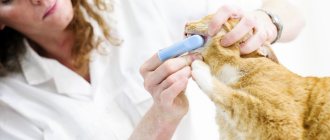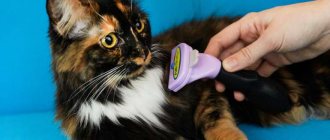Signs you need cleaning
You can understand that your pet needs ear cleaning after an examination. To do this, the ear is carefully turned inside out and examined.
It should be borne in mind that the cat may not like this, so you need to accustom him to the procedure from a young age.
If there is a lot of dirt in your ears, then you just need to clean them. But in some cases it is better not to self-medicate, but to immediately contact a veterinarian:
- Black plaque. It may indicate infection with ear mites, and may also be a sign of otitis media or other serious diseases. If left untreated, there is a high risk of deafness. After diagnosis, the doctor will prescribe ear drops depending on the form. Treatment must be carried out every day.
- Atypical formations. Consultation is necessary to determine the diagnosis. Most often, the course of treatment lasts from 15 to 20 days, then a re-examination by a specialist is required.
Other indications for ear cleaning:
- Large amount of sulfur. Ear cleaning is carried out as it accumulates, the frequency depends on the individual characteristics of the cat and breed.
- Exhibition. When attending various competitions, the cat must be clean, as the judges pay attention to such moments.
- Lack of wool. There is a risk of proliferation of pathogenic microflora, since there is no natural barrier protecting against dirt. Typical for hairless cats.
- After swimming. Remove residual moisture from the ear, this helps prevent the development of otitis media.
How often should you clean
There should be common sense in everything. Pedantic but inexperienced owners clean and “polish” the animal, which does not leave the apartment, every day. There is no need to poke the hygiene instrument into the sensitive cat's ear once again. If the cat is healthy, his behavior has not changed, and there are no external signs of illness, leave him alone.
In old reference books on veterinary medicine there is a recommendation: to clean your cat’s ears once a month (and not “when they get dirty”). The correct approach today: for a healthy individual, a preventive examination once a week is sufficient. If suspicious formations are detected, the hearing aid is cleaned.
A feature of some breeds (for example, Sphynxes) is considered to be a more frequent release of earwax. When purchasing a kitten, a reputable breeder issues instructions on care and feeding along with the documents. In any case, they wipe their ears without putting it off until tomorrow if they notice:
- light brown sulfur discharge;
- streaks of dirt on the inside.
If you notice redness or a rash in the ears, or an unpleasant odor appears, do not wash the cat’s ears yourself. Contact your veterinarian first.
Not every guide to caring for and raising a cat contains a section on “how to properly clean a cat’s ears.” This is the simplest manipulation, it only takes a few minutes: if you don’t rush, even a teenager can do it.
What to use when cleaning
All items for cleaning ears must be prepared in advance:
- Cotton buds. Factory products with limiters are used.
- Cotton pads.
- Special lotions. Can be found in veterinary pharmacies (Beaphar, Excel Ear Cleansing). In the absence of special solutions, they can be washed with Chlorhexidine, Miramistin, and hydrogen peroxide. Oil is often used to remove wax plugs, but it is better not to use this remedy.
- Flashlight. For a better overview, you can use a head-mounted one so that both hands are free.
- Towel or sheet. Not all cats tolerate such procedures calmly; they begin to break free and are not allowed to be cleaned; they are usually restrained additionally.
It is important to choose treatment products carefully; for example, when using Frontline, which contains alcohol, cats often drool.
Cleaning Frequency
Healthy cats' ears clean themselves. Sulfur is released to the surface when chewing. Plus, the animal itself removes its excess with its paw while washing, shaking its head. But some cats have a lot of discharge, and the owner must help the pet.
To understand when it's time to clean your cat's ears, you need to conduct periodic inspections. It is better to do this in good lighting. This makes it easier to determine the type of plaque and the condition of the auricle. Animals walking on the street are examined daily in order to promptly detect the presence of a foreign body.
How to properly clean a cat's ears
Processing must be consistent and correct:
- In order not to injure the pet or get scratches, it is fixed. To do this, use a sheet or blanket. They wrap the limbs and body of the animal, except for the head.
- Then carefully turn the ears out and inspect for dirt. If they are absent, the cat is released.
- If small dirty areas are found, wipe them with a dry cotton pad.
- If there is a lot of plaque, the ears are treated with a special lotion. Move from the inside out to prevent dirt from remaining in the ear canal. If necessary, dirty cotton swabs are replaced with clean ones until the entire surface is cleaned.
- Then, using cotton swabs soaked in a special product, carefully treat the bends and folds. It is not recommended to insert them deeply, as this can damage the eardrum.
- If wax plugs are detected, special ear drops (Otifri) are used to help loosen them. When instilling, massage the animal’s ear so that the product gets into the passage and is evenly distributed.
- After the procedure is completed, the cat is released and praised. Give a treat that improves the pet's mood.
Ear cleaning at the veterinary clinic
If your cat has a tick or a large accumulation of wax, you can take it to the veterinarian. The veterinarian will examine the animal, determine the disease if it is present, and clean the ear canals. However, you will have to pay a certain price for cleaning at the clinic.
Knowing how to clean your pet's ears can protect him from various diseases and prevent his hearing from deteriorating. If at first glance cleaning seems complicated, upon closer examination everything is elementary and can be done by any owner.
Mr. Cat warns: watch out for ear mites
The ear mite is a microscopic arthropod parasite that lives in the ear canal, whose diet includes epithelial cells. Identified by a dark brown coating on the inner surface of the ear. And also for the following reasons:
- The cat behaves differently than usual, is worried, often shakes its head, scratches its ears until it bleeds, and rubs against the furniture.
- An unpleasant odor emanates from the animal’s ears and dark crusts form.
- The cat's hearing is impaired and it does not immediately respond to calls.
If dark spots are found throughout the inner surface, you should treat them with lotion with silver ions (Cliny, Veda), which will remove plaque. Then drip with a special product (Tsipam, Decor-2, Otidez, Bars). Carry out the procedure according to the instructions for the drug until complete cure (2-3 weeks).
Examination of the animal's ears
What should alert you when examining a cat’s ears:
- First, the inside of the cat's ear should be warm, clean and slightly oily.
- If the sulfur inside has darkened and acquired a rich rusty-brown color, and before this the cat vomited or had purulent-bloody discharge from the nose, there is a reason to consult a doctor. Perhaps the animal becomes anemic and urgently needs iron supplements.
- A similar picture is observed in kittens if they have polyps (adenoids) in their nose. Polyps can grow directly in the ear canal!
- This is most likely impossible without surgical intervention.
- If sulfur has acquired a dull yellow color and is released (flowing) profusely from the ear opening, then there is clearly a purulent process. The presence of white or greenish clots is confirmation of this.
- Fever, refusal to feed, lethargy are accompanying symptoms of otitis media.
Let's run to the doctor! We urgently need antibiotics or antiviral drugs!
If black inclusions are noticed in the earwax once, then there is no need to worry - most likely, dirt has gotten into the ear. It is enough to clean the auricle with a cotton swab or disk. If there are no small inflamed areas under the dirt, and the ear canal itself is clean, then there is no reason to panic.
It’s another matter if, after wiping, “dirt” appears again and again, its boundaries expand, the delicate inner lining of the ear becomes inflamed, and the wax on the tampon spreads out in dirty, bloody stains - a bad sign. This could be otomycosis, because. Fungal spores can turn sulfur black. Presence of blood – ear mite – Otodectes cynotis (lat.). And this is the beginning of ear frequency.
Symptoms are noticeable even without earwax:
- increasing itching;
- bowed head, etc.
Attempts to scratch the ear result in additional damage, which does not add a good mood to the unfortunate animal; it becomes nervous and aggressive. The temperature may rise.
Most often, the disease manifests itself in small kittens and the danger accompanies up to a year.
Why is a visit to the doctor necessary? Because under a microscope he will be able to determine what is preventing the cat from living in peace - a fungus or a mite. Perhaps both together.
If the sulfur is completely colorless or has a milky white color, then this is also a reason to consult a veterinarian. Perhaps this is a sign that the cat’s body lacks microelements or hypovitaminosis begins.
This question should not be started, because... a young animal that does not receive these building materials during the growth period will never be able to feel absolutely healthy. The doctor (after tests) will prescribe the correct treatment.
The combination of clear exudate from the ears, nose and eyes at the same time is an allergic reaction.
A dry ear from the inside, covered with wax, flaking off with whitish scales, like large dandruff, is a sign of a lack of fat in the cat's food or the beginning of dermatitis.
The doctor will make an accurate diagnosis. He will determine, after a detailed examination, whether the constant discharge from the ear is an internal birth injury in the kitten or a deep inflammatory process.
When examining your cat's ear, don't be shy to smell it! Smell can say a lot! For example, with a staph infection, an unpleasant fishy odor will emanate from the ear. The smell of rotten meat will indicate suppuration, although this may not yet be visible outwardly.
A sharp, pungent odor can appear from the ears of cats during the period of “maturation” or sexual heat. A sharp and unpleasant odor may also indicate a thyroid disease.
Attention! The appearance of ichor or drops of blood from a cat’s ears is an ear injury with damage (worse if ruptured) to the eardrum! Go to the veterinary clinic immediately!
The most common ear problems
In addition to ear mites, pets often encounter other diseases that require treatment, and if left untreated, lead to serious complications.
Otitis
Otitis is a disease in which the ear canal is affected by bacteria or yeast.
It is characterized by the following symptoms:
- purulent discharge with an unpleasant odor can be observed from the ears;
- the cat shakes its head intensely;
- the mucous membranes of the ears turn red and swell;
- The pet constantly scratches itself and meows.
Therapy is prescribed by a veterinarian after examination. Self-medication can cause complications and lead to inflammation or deafness.
Hematomas
Formed due to ruptures of blood vessels.
Reasons: The cat often shakes its head or scratches its ears. They can be identified by small burgundy spots between the auricle and the skin.
Solar dermatitis
Albinos, hairless cats and pets with white ears are susceptible to this disease. Solar dermatitis can be identified by redness of the skin and hair loss at the edges.
If you don't take action, the itching may cause your cat or cat to scratch its ears and cause an infection. There is a risk of tumors.
Squamous cell carcinoma
This neoplasm is a consequence of solar dermatitis. It affects various areas of the skin, but most often develops on cat ears. The main symptoms include red spots, lumps and hair loss. There may be ulcers that do not heal for a long time.
Frostbite
Due to hypothermia, there is a risk that the ear tissue will collapse. It can be identified by changes in skin color, first it loses color and then turns red. At the last stage it turns black and begins to peel off.
Restless behavior is caused by otitis media, ear mites, fleas or allergies. Only an established cause will help solve the problem.
To make an accurate diagnosis and correctly prescribed treatment, it is necessary to consult a specialist.
What not to do
When cleaning your cat’s ears at home on your own, you should not do the following:
- Try to penetrate as deep into the ear canal as possible.
- Use folk remedies due to the risk of developing allergies and damage to the epidermis of the ear canal.
- Clean it yourself if there is redness, purulent discharge, or an unpleasant odor.
- Try to achieve perfect cleanliness and clean often. Sulfur is needed.
- Use medicated ear drops as a cleaning agent.
Ear cleaning procedure
Before starting the procedure, prepare everything you need.
The upper part of the ear is cleaned with a cotton sponge or neutral wet wipes.
For the lower one, it is advisable to use children's cotton swabs with limiters - this way there is less risk of injuring the animal. You need from 2 to 4 of them for each ear, depending on the degree of contamination. You should not use the same stick for different ears, even if it seemed to remain clean.
Prepare enough blades and chopsticks so that you don't have to take a break because you don't have enough.
Do not use homemade matchsticks - the cotton wool can easily slip off and remain in the ear. In addition, in this case there is a high risk of scratching the animal.
Some experts do not recommend using sticks at all, noting that there is a risk of only pushing the sulfur deeper. Instead, they suggest pouring in the cleanser one at a time for several days in a row until the stains are gone.
If possible, prepare a small flashlight - it will allow you to better examine the auricle. If necessary, warm the cleanser to room temperature.
It is best to carry out cleaning when the cat comes on its own and asks for attention or is half asleep. During the procedure, talk quietly and gently to your pet to calm him down.
How to clean a cat's ears:
- Place your pet on a table or in your arms. If he is calm about the procedure, you can simply hold him with your hand; if he breaks out, carefully swaddle him in a towel or call an assistant.
- Gently turn the ear outward - this is not painful and will not harm the animal. With fold-eared cats, as well as those with curled ears, for example, curls and lefties, you need to act especially carefully. Carefully examine the ears for symptoms of disease.
- Place 5-7 drops of lotion or saline solution into your ear - the manufacturer should indicate the exact dose. For kittens, 2-3 drops are enough. Gently massage the base of your ear for a minute.
- Allow the cat to shake its head and shake the liquid and loosened dirt out of the ears. For light contamination this is sufficient.
- If the ear is heavily soiled, wipe the upper part of the ear with a sponge and clean the lower part with a cotton swab. It can be immersed to a depth of up to a centimeter, for kittens - half a centimeter. Don't be afraid to pierce your eardrum - this is impossible due to the curves of the auricle, although you still need to act carefully. Move the wand outward rather than inward to remove dirt rather than push it deeper.
- After cleaning is complete, praise and pet the animal and reward it with a treat.
Accustoming kittens to the procedure
It is very important to teach your pet to calmly endure the ear cleaning procedure, otherwise in the future, by struggling and resisting, he will complicate the owner’s task, and besides, by jerking at the wrong moment, he can seriously harm himself.
It is advisable to play with the baby in advance so that he gets tired and calms down. It’s not worth interrupting the game in the midst of it - the kitten will be too excited and will probably resist, and the procedure in this case will cause unpleasant associations for it.
An animal accustomed to the procedure from childhood most often perceives it calmly.
Stroke the prepared animal, talk softly and affectionately to it to calm it down. If the kitten still resists touching its ears, you can restrain it by carefully wrapping it in a towel. Please note that you cannot express your dissatisfaction with the animal or scold it, much less act rudely. Even when swaddling a kitten, speak in a friendly manner. Praise him in moments of calm and obedience.
After completing the cleaning, be sure to give the kitten a treat and, if he wants, play with him - the procedure should be associated with pleasure.
The attitude towards ear cleaning largely depends on the character of the animal. Our first cat never struggled or showed aggression during the procedure; he only pressed his ears to his head with force, so it took some effort to straighten them. Since at the same time he usually sat quietly next to her, without trying to escape, it seemed that he saw this as a kind of game.
If your pet reacts aggressively to the procedure, trim the nails in advance or attach anti-scratch guards to them.
Cat ear cleaners
The best choice for cleaning an animal's ears is a product specifically designed for this purpose.
Lotions
Lotions are the most popular and widespread means for cleaning cat ears.
Leopard
Bars lotion dissolves sulfur and dirt, helping to get rid of them easily. It has a mild anti-inflammatory, analgesic and anti-edematous effect. Some experts recommend this lotion as an adjuvant in the treatment of fungal diseases, since it increases the sensitivity of microflora to antibiotics.
The product not only removes dirt, but also helps fight pathogenic microflora
Packaging - bottles of 15, 20 and 25 ml. The average price of a 20 ml bottle is 90–120 rubles.
The liquid has an oily consistency and may stain clothes!
Since we had an advanced case, it took a lot of time to clean our ears. I divided the procedures for each day. It’s better to take a little bit at a time than to pour out half a bottle of Bars at once. So, we introduce 3-5 drops into each ear. The smell of the lotion is strong, so you have to keep the animal in check - otherwise it will run away and won’t be given any more) After massaging my ears, I wrapped cotton wool around long tweezers, which I also soaked in the lotion. And with this device we clean the ear cavity. Such horror came out of the kitten’s ears... And how did all this just fit into her... In general, every day I cleaned her ears, and, finally, they took on a decent appearance)
Muchacha
https://irecommend.ru/content/bars-otlichno-ochishchaet-ushki-ot-vsyakoi-byaki-podoshel-dazhe-dlya-malenkoi-koteiki
1. First of all, the lotion is very difficult to dose. The tip is very thick, the bottle itself is somehow incomprehensibly pressed, which is why the only way to understand how much lotion you are pouring in is to pour it past your ears and look with your eyes. 2. The lotion has an unpleasant smell. If it accidentally gets on your fingers, you have to wash your hands several times to get rid of it, and even then the subtle “aroma” may remain for another couple of hours. 3. The consistency is very greasy, and no matter how carefully you use the product, the hair around the ears still becomes greasy and does not wash off with water the first time.
Euphorie_
https://irecommend.ru/content/mozhno-naiti-bolee-udobnye-v-ispolzovanii-sredstva-togo-zhe-kachestva-i-za-te-zhe-dengi
Euracon Pharma GmbH OTOKLIN
Otoklin lotion contains substances that soften sulfur and moisturize the skin. Suitable for breeds prone to ear infections. It has an exfoliating effect, helps get rid of dead skin cells, and soothes it.
The package contains 18 bottles of 5 ml. One bottle is enough for one-time cleaning of both ears of a cat. Average price 900–1100 rub.
Within half an hour after instillation of the product, you cannot use other ear medications!
The product should not be used simultaneously with other ear medications.
To clean the abundant wax and dirt, we were recommended to use Otoklin in both ear canals of the cat every 24 hours for 8 days until the ear canals are completely cleaned. I put a little product in each ear and massaged the ears. The cat, of course, was unhappy with this process, but endured it. After a 30-second massage, I released the cat and he shook his head and got rid of the remnants of earwax, which scattered along with the remnants of Otoclin) The ears look much cleaner immediately after the procedure!!!
toptipja
https://irecommend.ru/content/profilaktiki-otitov-takzhe-ushnnykh-kleshchei-i-zabolevanii-oslozhnennykh-bakterialnoi-infek
VETOQUINOL Otifri
Otifri lotion intensively dissolves sulfur and dirt. When used regularly, it has a beneficial effect on the “good” microflora of the ear. Protects the skin from drying out and eliminates itching.
The lotion moisturizes and soothes the skin
The drug is packaged in 60 or 160 ml bottles. The average price of a 60 ml bottle is 600–700 rubles.
I am the owner of cats and dogs. We have 6 ears. Animals look after each other themselves, but sometimes they also have to be backed up. The lotion is great for these purposes. Otifri is a cleansing lotion with calendula for cleaning the ears. Otifri is not just a cleansing lotion, it is also a caring lotion for the ears. Lotion that dissolves earwax and dirt. I apply it to a cotton pad and wipe my pets’ ears. Due to the content of calendula, Otifri lotion, judging by the description, not only normalizes the structure of the skin, but increases its resistance, moisture and elasticity. I'm happy with everything about it. The most important thing is the natural composition. I don't worry about cleaning my dog's ears and then the cat going and licking the lotion.
Usersha
https://irecommend.ru/content/idealnyi-67
I bought Otifri for my sphinxes as a hygienic ear care product. Let me say right away - the lotion is excellent. Cleans ears perfectly. They get dirty much less after using the lotion. The smell is pleasant. […] Now about the disadvantages - the price! It is unreasonably high for such a composition.
Olga Konovalova
https://irecommend.ru/content/otlichnyi-loson-no-platite-za-brend
Veda
Ear lotion with Veda phytocomplex gently cleanses animal ears. Contains a phytocomplex of 25 plants, has antiseptic, healing and anti-inflammatory properties.
The drug helps fight inflammation of the ear
Bottle - 15 ml. The price ranges from 50 to 190 rubles.
Cleans well, leaves no oil marks, does not leak. The kitten tolerates it calmly. The composition is good, the price is very affordable.
Ekaterinamama2
https://irecommend.ru/content/mozhno-ispolzovat-kazhdyi-den-stoit-nedorogo
Wet wipes
Wipes soaked in a special solution do not provide deep cleaning, but are good for removing dust and surface dirt on the top of the ear. Some can also be used to cleanse the eyes.
A popular option is TEDDY PETS For eye and ear care. Contains vitamin A and cornflower flower extract. They have anti-inflammatory, soothing and antibacterial effects.
Wet wipes are very convenient on the go
We took kittens from the street and they had big problems with their eyes and ears. We went to the veterinary clinic and they recommended eye drops and ear wipes. An excellent product that has saved me many times. They cleaned up all the dirt right away, but they were spinning around and there was no way to calm them down. They’ve just been brought into the house from the street, they’re scared, but for some reason they’re getting into their ears and eyes. Therefore, I didn’t want to torture them for a long time, and that’s where these napkins came to my rescue. Quick cleansing around the eyes and instantly clean ears, as soon as I put them on the floor, they immediately rushed under the bed)
luba_gib
https://irecommend.ru/content/spasli-menya-ne-odin-raz
The following napkins are also common:
- "Gamma" for eye and ear care;
- ESPREE Ear Care Wipes;
- Nutri-Vet “Clean ears”.
Sprays
In this case, the cleaning agent is sprayed with a spray bottle.
Common products include the drug “TOP VET Fitolar”. Contains extracts of calendula, chamomile and sea buckthorn seeds. The product softens impurities, moisturizes the skin and promotes its elasticity. It has a bactericidal and anti-inflammatory effect, accelerates skin regeneration after microtrauma.
Gels
Gels have a denser consistency than lotions, but otherwise act similarly. Some liquefy quickly upon contact with warm skin.
The following gels are suitable for cleaning cat ears:
- Merial Frontline Pet Care;
- Dermoscent PYOclean;
- Artero AURIGEL Ear Cleaner.
Other means
In addition to branded products, you can use sterile saline solution to clean cat ears - it is sold in regular pharmacies.
Some owners recommend using vegetable oil, such as olive oil. This method must be approached carefully so that a greasy film does not form on the animal’s ear. The oil should not be poured or dropped into the ears; if necessary, lightly moisten a sponge or cotton swab with it.
Unsuitable substances
Never use water to clean your cat's ears! Once inside, it can cause diseases, including otitis media.
You cannot use hydrogen peroxide, chlorhexidine, alcohol-containing products and soap solution - they will dry out the delicate skin of the ear, which will lead to the appearance of ulcers, wounds and even more active wax production.
Some of these substances are used in ear medications, but should only be prescribed by a veterinarian after an accurate diagnosis.
When to clean your ears
Healthy ears have no odor, and earwax is normally dark in color.
Cleaning your kitten's ears is a must.:
- with increased sulfur secretion. There is no reason to panic, but its excessive accumulation can cause inflammation, so if your pet suffers from this, then it needs frequent procedures for cleaning the sinks;
- excess hair in the ears. It happens that cats have hair that accumulates in their ears and clumps into lumps. They do not allow air to pass through, and can cause the accumulation and reproduction of various viruses and bacteria;
- after taking a bath. If you do not remove the moisture that may remain after bathing, then inflammation of the middle ear - otitis media - can easily occur;
- before an exhibition, competition;
- daily cleaning is recommended for diseases and inflammatory processes;
- If you suspect any disease, if there is discharge, you should not delay going to the veterinarian.
The importance of cleaning cats' ears
The ears of animals are an important paired organ. They help cats easily navigate the surrounding space and maintain balance. All warm-blooded animals produce sulfur secretion in their ears, including humans and cats. The substance is a protective mechanism; it protects the eardrum from various contaminants. Excessive layering of secretions often causes the formation of sulfur plugs and becomes a source of inflammation and other diseases. Dirt in a cat's ears, in addition to causing illness, can become a fertile ground for infection with ear mites.
Cleaning ears for otodecosis and other diseases
Ear cleaning for diseases can be done both at home and in a veterinary clinic.
Cleaning at home
It is important not to remove the contents of the ears before the initial visit to the veterinarian, as this will complicate the diagnosis; Before starting treatment, it is necessary to conduct microscopy of scrapings and take cultures. All medicinal prescriptions are made only by a veterinarian. Self-medication is dangerous due to the formation of antibiotic-resistant bacterial flora, chronic inflammatory process and its spread, including to the meninges, which will cause the death of the cat.
Otodecosis
Otodecosis does not pose a danger to humans, but in some cases allergic reactions are possible. Otodecosis is dangerous for other cats, as well as dogs. They can be treated with conventional medications to prevent tick attacks. A cat's ears are very sensitive, and the sensitivity of diseased ears increases significantly, so it is necessary to provide protection from the cat's teeth and claws by securely fixing it. A sick cat is more likely to react aggressively than the same cat in a healthy state.
Cleaning the ears for otodecosis includes regular hygienic cleaning, as well as the application of medicinal products.
Good results are achieved by using the following means:
- 0.05% aversectin ointment; it is applied generously to the entire inner surface of the auricle and the external auditory canal twice with a week interval between treatments;
- tanacetos or polysulfide liniments; also applied twice, interval - 7 days;
- 3% creolin, externally, twice applied with an interval of 7 days;
- solutions of veterinary insectoacaricidal drugs: Neostomazan, Stomazan, Butox, Ectomin, Baytikol, applied externally, twice with an interval of 10 days; the inner surface of the auricle, the external auditory canal, the hair on the ear and next to the ear are treated;
- Amidel Neo gel - will contain cyfluthrin, which affects ticks; chlorhexidine to treat concomitant bacterial inflammation, as well as lidocaine, which will immediately relieve the cat’s itching; after the usual cleansing of the auricle, the inner surface of the ear is thoroughly wiped with a cloth soaked in the gel and 0.5 g of gel is squeezed into the lumen of the ear; the drug is supplied in a convenient dosing syringe form;
- amitrazine preparations (Amitraz, Tsipam) - they are treated 3-5 times with an interval of 4-5 days;
- hexachlorane preparations (Aurikan) - instilled into the ear daily for a week, then 2 times a week for a month;
- drops on the withers also kill ear mites - Frontline, Stronghold, Bars.
It is possible to independently prepare a remedy for the treatment of ear mites, if it is possible to obtain the components and this composition is approved by the attending veterinarian:
- 20 g unsalted rendered pork lard;
- 8 g potassium carbonate;
- 15 g colloidal sulfur.
All components are thoroughly mixed and the resulting product is applied externally, every 2-3 days, until the symptoms completely disappear.
Otitis
If the cause of the cat’s illness is external otitis, then use:
- ear drops - to influence the bacterial flora Otospectrin, Otobiovet, Otobiovin, Polyseptin; for additional impact on the accompanying fungal flora - Aurizon, Surolan, Mometamax, Isotik, Posatex;
- broad-spectrum antibacterial drugs (according to indications) - Sinulox, Tsiprovet;
- painkillers - for severe pain - Loxicom.
A cotton swab soaked in camphor alcohol, wrung out and left in the pet's ear for several hours under a compress will provide good help as a home remedy.
Scratches and other damage
If scratches, abrasions, hematoma, or lymphatic drainage are found in the ear, then:
- hematomas and lymphatic extravasates are opened and emptied in a veterinary clinic, otherwise a focus of purulent inflammation is formed, upon healing of which a permanent deformation of the ear is formed; then treatment is carried out with chlorhexidine or Levomekol ointment;
- scratches and abrasions are treated with chlorhexidine.
Photo gallery: ear diseases in cats
With otitis externa, the kitten has noticeable redness of the skin of the ears.
A hematoma of the external ear in a cat can only be opened in a veterinary clinic.
Otodecosis is caused by mites
Ear cleaning in clinic
It is advisable to carry out routine ear cleaning at a veterinary clinic if this is the owner’s first cat and there is no experience at all in caring for ears. The clinic will explain and show you how to take care of your ears. Also, owners of aggressive animals can contact the clinic for hygiene and therapeutic procedures. The cost of ear cleaning at a veterinary clinic varies from 150 to 750 rubles.
With a long course of the disease and the formation of cerumen plugs, the far part of the ear canal becomes clogged, and the possibility of penetration of drugs there is reduced. In this case, to reduce the treatment time for external otitis, hardware ear lavage may be prescribed. It is performed under sedation using special sanitation systems, for example, the Welch Allyn device. The feasibility of the procedure is determined by a veterinarian. An absolute contraindication is a violation of the integrity of the eardrum.











